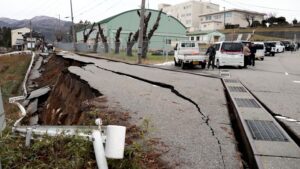TOKYO (Reuters) — A powerful earthquake struck central Japan today, killing at least one person, destroying buildings, knocking out power to tens of thousands of homes and prompting residents in some coastal areas to flee to higher ground.
The quake with a preliminary magnitude of 7.6 triggered waves of about one meter along Japan’s west coast and neighboring South Korea, with authorities saying larger waves could follow.
Two people were feared dead in Nanao on the Noto Peninsula, police said, after they were both found showing no vital signs. Authorities in Japan do not typically confirm deaths until determined by a coroner.
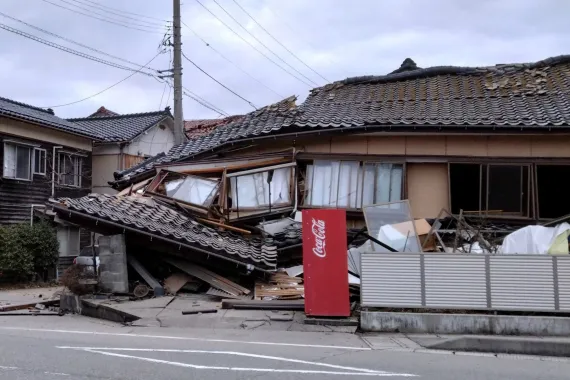
The Japan Meteorological Agency (JMA) issued tsunami warnings for the prefectures of Ishikawa, Niigata and Toyama. A major tsunami warning – the first since the March 2011 earthquake and tsunami that struck northeastern Japan – was initially issued for Ishikawa but later downgraded.
Russia and North Korea also issued tsunami warnings for some areas.
Houses have been destroyed, fires have broken out and army personnel have been dispatched to help with rescue operations, government spokesperson Yoshimasa Hayashi told reporters, adding that authorities were still assessing the damage.
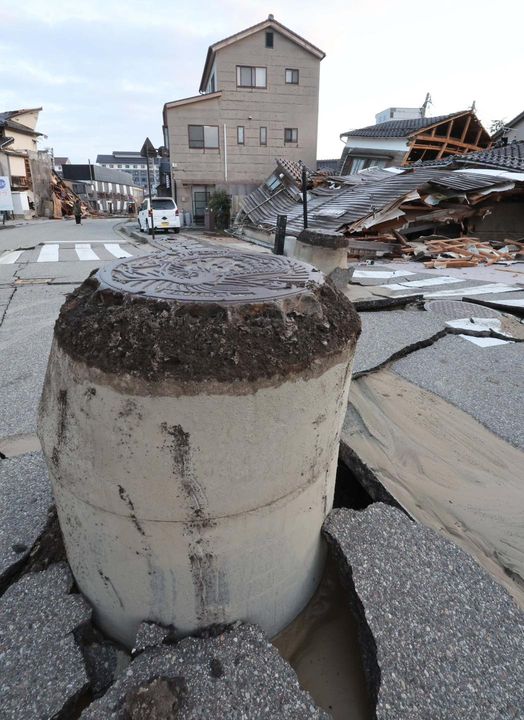
Picture of a Japanese sewer that raised up during the earthquake.
One elderly man was pronounced dead after a building collapse in Shika Town in Ishikawa, broadcaster NTV reported citing local police.
Japanese Prime Minister Fumio Kishida told reporters he had instructed search and rescue teams to do everything possible to rescue lives, even though access to quake-hit areas is difficult due to blocked roads.
More strong quakes in the area, where seismic activity has been simmering for more than three years, could occur over coming days, JMA official Toshihiro Shimoyama said.
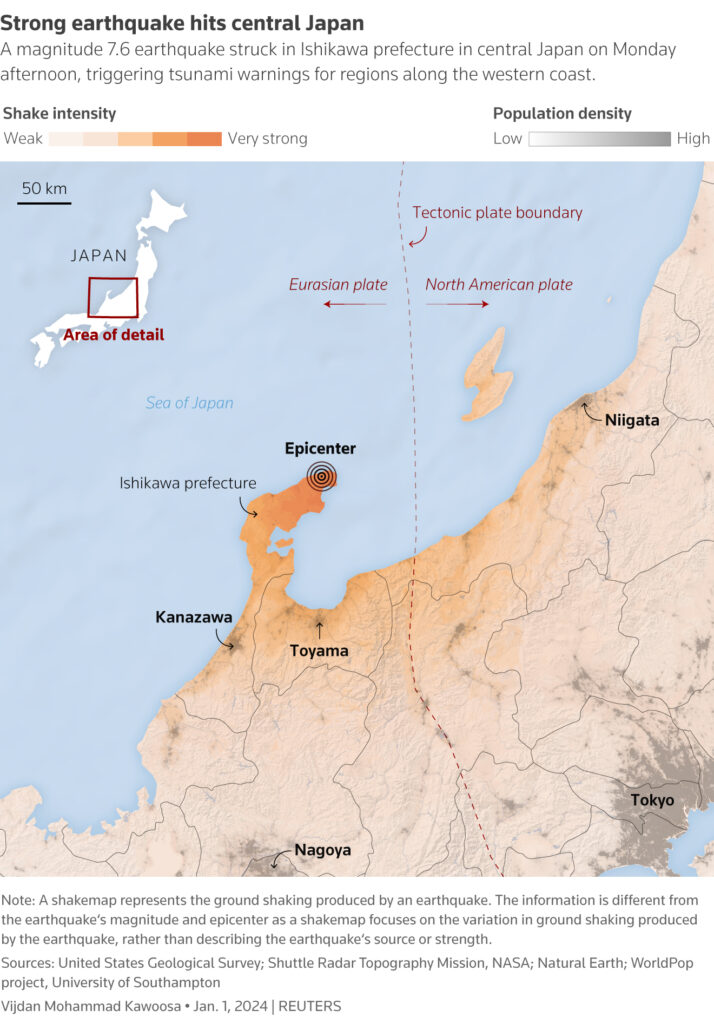
In comments to the press shortly after the quake struck, Kishida also warned residents to prepare for more disasters.
“I urge people in areas where tsunamis are expected to evacuate as soon as possible,” Kishida said.
“Tsunami! Evacuate!” a bright yellow warning flashed across television screens advising residents in specific areas of the coast to immediately evacuate their homes.
Images carried by local media showed a building collapsing in a plume of dust in the city of Suzu and a huge crack in a road in Wajima where panicked-looking parents clutched their children. There have been reports of at least 30 collapsed buildings in Wajima, a town of around 30,000 known for its lacquerware, and a major blaze has engulfed several buildings.
The quake also jolted buildings in the capital Tokyo, some 500 km from Wajima on the opposite coast.
More than 36,000 households had lost power in Ishikawa and Toyama prefectures, areas where temperatures where set to drop to near freezing overnight, according to utilities provider Hokuriku Electric Power. Telecoms operators also reported phone and internet outages in some areas.
Forty train lines and two high-speed rail services to the quake-hit area halted operations, while six expressways were closed and one of Ishikawa’s airports was forced to shut due to a crack in the runway, transport authorities said.
Japanese airline ANA turned back planes headed to airports in Toyama and Ishikawa, while Japan Airlines cancelled most of its services to the Niigata and Ishikawa regions.
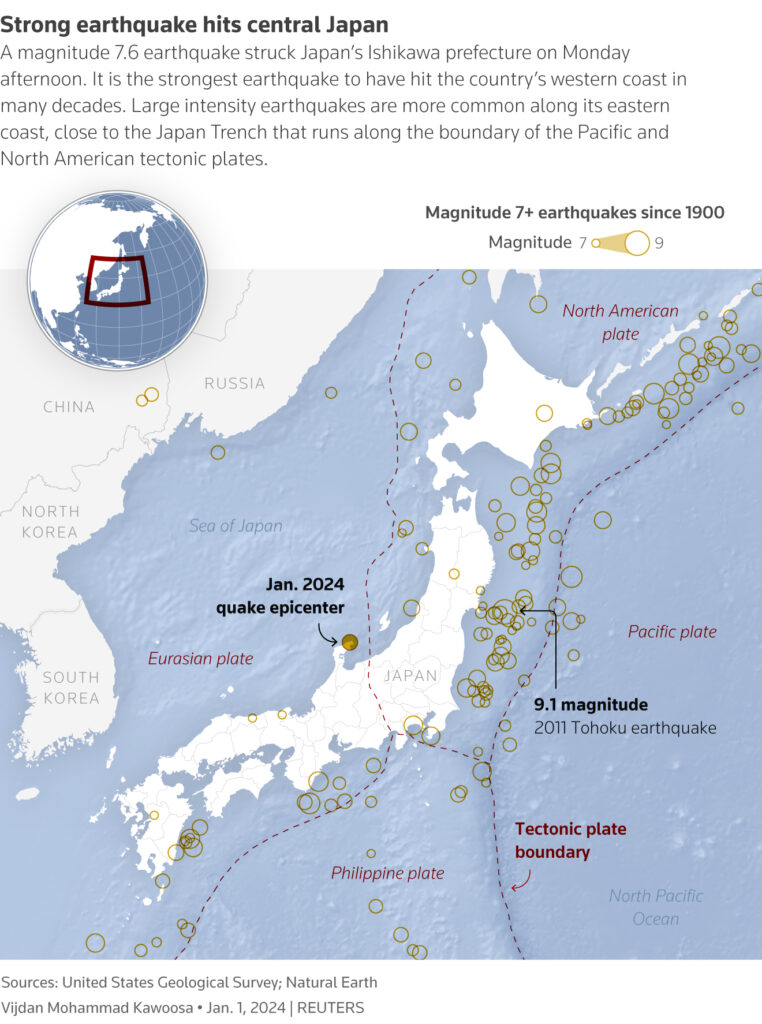
NUCLEAR PLANTS
The quake comes at a sensitive time for Japan’s nuclear industry, which has faced fierce opposition from some locals since a 2011 earthquake and tsunami triggered nuclear meltdowns in Fukushima. Nearly 20,000 people were killed and whole towns devastated in the disaster.
Japan last week lifted an operational ban imposed on the world’s biggest nuclear plant, Kashiwazaki-Kariwa, which has been offline since the 2011 tsunami.
Japan’s Nuclear Regulation Authority said no irregularities have been confirmed at nuclear power plants along the Sea of Japan, including five active reactors at Kansai Electric Power’s Ohi and Takahama plants in Fukui Prefecture.
Hokuriku’s Shika plant in Ishikawa, the closest nuclear power station to the quake’s epicentre, had already halted its two reactors before the quake for regular inspections and saw no impact from the quake, the agency said.
Monday’s quake struck during the Jan. 1 public holiday when millions of Japanese traditionally visit temples to mark the new year.
In Kanazawa, a popular tourist destination in Ishikawa, images showed the remnants of a shattered stone gate strewn at the entrance of a shrine as anxious worshippers looked on.
Kanazawa resident Ayako Daikai said she had evacuated to a nearby elementary school with her husband and two children soon after the earthquake hit. Classrooms, stairwells, hallways and the gymnasium were all packed with evacuees, she said.
“We haven’t decided when to return home yet,” she told Reuters when contacted by telephone.
The jolt was also felt by tourists who had flocked to Japan’s mountainous Nagano region for the start of the snow sports season.
Johnny Wu, a 50-year-old Taiwanese snowboarder, was waiting for a shuttle bus back to his hotel in the resort town of Hakuba when the quake hit, rattling windows and shaking snow of roofs and overhead electric wires.
“Everybody was panicked at that time. I’m a little bit better because, I come from Taiwan, so I’ve experienced a lot. But…(I’m) still worried about (the quake) getting more serious,” he said.
Reporting by Tim Kelly, Satoshi Sugiyama, Kantaro Komiya, Sakura Murakami, Chang-Ran Kim and the Tokyo newsroom; Additional reporting by Nicoco Chan in Shanghai; Writing by John Geddie; Editing by Kim Coghill, Neil Fullick and Louise Heavens
Our Standards: The Thomson Reuters Trust Principles.

